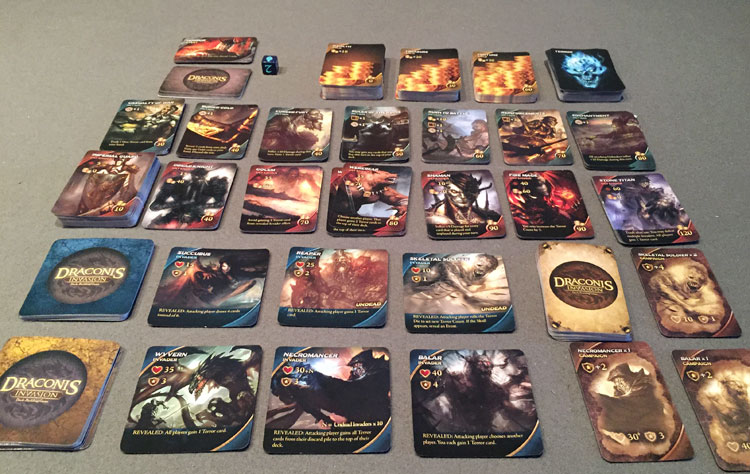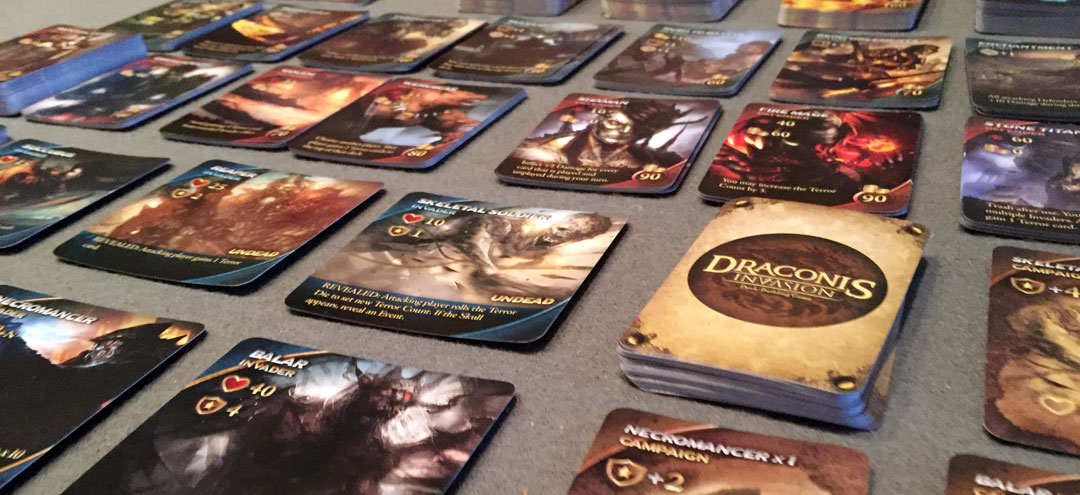 Back in 2008 when Donald X. Vaccarino dropped his deck builder Dominion (review) on the gaming world, I wonder if he knew what he was starting. Dominion quickly took the gaming world by storm and has since inspired a plethora of other deck building games.
Back in 2008 when Donald X. Vaccarino dropped his deck builder Dominion (review) on the gaming world, I wonder if he knew what he was starting. Dominion quickly took the gaming world by storm and has since inspired a plethora of other deck building games.
Today, we are going to be taking a look at Draconis Invasion, a new deck builder from publisher Keji Inc. While this new card game clearly draws some inspiration from Dominion, it also boasts some unique mechanics that could help it stand on its own. Does it succeeded? Let’s find out.
Draconis Invasion is a deck building card game for 1-6 players that takes about 45 minutes to play. Draconis Invasion plays best with 3-4 players.
Game Overview:
Hordes of invaders have appeared on the eastern borders of the kingdom and the King has charged the players with recruiting troops to repel them. In game play terms, players will be using their starting deck of gold and defender cards to try and build up an army of increasingly powerful cards. Players will be purchasing action cards, new defenders, and more lucrative forms of income. Eventually players will be fighting the invaders, earning them valuable glory points in the process. Once the invasion has been repelled, the player with the most glory will be crowned the King’s champion.
Game Components:

The first thing you’ll notice about the components in Draconis Invasion, other than the amount of cards, is the fantastic artwork. This is the first game I’ve seen from Keji, and I really enjoyed the fantasy style artwork. Even the artwork for the coins has me coveting them. The game’s box also has PLENTY of room, so clearly they are planning for future expansions. Frankly, I always prefer when game publishers plan ahead, as I hate having keep extra boxes on the shelf for expansions.
The cards in Draconis Invasion come in a quite a few different types: Actions, Defenders, Campaign, Monsters, Terror, Money, and Events. Players start the game with a 12 card deck of 5 guards and 7 wealth cards. The rest of the available cards will be determined by the game’s random setup, as only about half of the defenders and action cards are used in each game.
How to Play:
If you’ve ever played a deck builder before, you should be able to pick up Draconis Invasion pretty easily. Once the cards are chosen and sorted into various piles, you’re ready to begin.
Draconis Invasion uses a clever A-BCDE-F system to guide a player’s turn.
A – Action: You may play 1 action card from your hand.

You may then do ONE of the following:
B – Buy: You may buy either an action card or a defender card paid for by discarding enough gold cards from your hand.
C – Campaign Cards: You may draw two campaign cards. These are essentially secret goals that award you bonus glory points for killing the appropriate invaders.
D – Defeat: You may defeat one invader by playing defender cards from your hand. All defenders have an attack value and also a gold value. Defenders are essentially mercenaries and their gold costs (not the same as their purchase cost) must be payed each time you use them.
E – Eliminate: Trash a non-terror card from your hand.
F – Forward: Finally, the player may forward one unused gold card from their hand to the top of their deck.
Defeated invaders go into a player’s score pile. A new invader is immediately revealed, usually with a reveal power that hurts the attacking player.
Many cards will also give players Terror cards. These are essentially waste cards that simply serve to clog up a player’s hand. Each time a terror card is discarded, the terror die (a d6) is ticked up one number. When it gets to the 6, an event card is drawn. Event cards are always bad and usually target the player with the most kills.
Turns will go by in this manner until either one player has either killed 6 invaders or all the event cards have been revealed. Players earn glory from defeated invaders and completed campaign cards. The player with the most glory wins.

Game Experience:
While Draconis Invasion definitely shows some inspiration from Dominion, I liked that it introduced a bunch of new mechanics that really help it to feel unique. Designer Jonathan Lai did a good job of putting his stamp on this game that helps it to stand out in a sea of deck builders.
Most people probably know how a deck builder plays, so let’s dive into what makes Draconis Invasion unique. One of the most creative ideas for me was how the defenders are used. I thought that the idea of them being essentially mercenaries was a clever design choice. Not only do you have to buy them for your deck, but you have to pay to use them each time. This forces players to think about the composition of their deck throughout the game.

In most deck builders, the obvious play is to always buy the most expensive card you can afford. However in Draconis Invasion, also you need to also think about if you can fund this defender going forward. Having a powerful monster isn’t going to do you much good if you can’t afford to reliably use him.
On the other hand, I do think that the use costs on many of the defenders feel a bit high. More than once I’ve drawn a good defender and not been able to actually play it. That can feel particularly frustrating, especially when I usually have that gold amount. I think if the costs were brought down some, you could still retain the mercenary feel without having the game be so punishing with an unlucky draw.
This has the added effect of making the early game of Draconis Invasion feel pretty scripted. The first few rounds usually have players buying more powerful gold cards, and then eventually trying to weed the original cards out. I’m all about deck optimization, but pretty much everyone has to do this if they want to use anything other than the basic defenders. Unfortunately, this can make the early game feel pretty boring, as players repeat the same turn until they start drawing those more powerful gold cards.
Moving on, the Terror cards in the game were a neat idea, and I liked how they were tied to the event cards. This not only helped to give the game a natural timer, but also worked as a good balancing mechanic for some of the more powerful cards.

Yet on the other side of the coin, I wasn’t a fan of the event cards that were tied to them. The event cards were clearly a catch up mechanic and almost all of them beat down the player with the most kills in some way. The problem with these are two fold. First, a catch up mechanic feels unnecessary in this game. Almost all the action and defender cards feel properly balanced, and after you defeat an invader, the game already punishes the attacker with the reveal mechanic.
The other effect is has is it punishes a player who grabs an early kill. There is an invader that will take only 15 attack power to defeat. A player could easily kill them in the first round with a good draw. The problem is that they are then the target of every event card unit another player catches up. Depending on what new invader is drawn, this could be for a good 25%-50% of the game due to the slow early ramp up. Those 10 point are just not worth painting a target on yourself early on.
I would have much preferred more variety in the event cards and ditching the catchup mechanic. Something that affects either the group as a whole, or the game in new and intriguing ways. Right now they feel really lack luster.
Finally, the introduction of campaign cards was a great idea. Not only does it give players something to do on their turn if they have a crappy draw. But it also gives players small goals to work towards during the game, earning them extra glory points. I was a big fan of these.
Final Thoughts:
Overall I thought that Draconis Invasion was a good game that could probably have used bit more refinement. Many of the new mechanics were great ideas, yet some, like the event cards and the defender price, need some adjustment in my opinion. Fortunately, I think many of my concerns about the game could be easily remedied with an expansion. New event cards would be a welcome change.
Draconis Invasion does have some nice replay value and I do enjoy the variety in the action cards. While most aren’t very powerful (don’t expect big chaining turns here), they all feel quite balanced. Draconis Invasion has a good amount of variety and should have plenty of replay value. And considering the size of the box, I’d imagine plenty of expansions are in the works.
While not perfect, Draconis Invasion does a lot of things right. The rulebook is already in its second edition as the publisher is clearly listening to criticisms of the game and taking it to heart. We played with the version 1.1 rules and found them to be a great improvement over the original ruleset. Keep an eye on Draconis Invasion, while I think it’s still a good game, a few tweaks could make it a great one.
If you’d like to pick up a copy of Draconis Invasion, you can get it for about $55.
Final Score: 3 Stars – A solid deck building game that introduces some clever mechanics, a bit more refinement could make a good game into a great one.
 Hits:
Hits:
• Campaign cards are great for small goals
• Requires deck optimization to be successful
• Excellent artwork
• Clever new mechanics for a deck builder
Misses:
• Early game feels a bit scripted
• Event cards feel unnecessary as a catchup mechanic
• Defenders use costs could be reduced some























Really enjoyed your review! Your thoughts are well organized and presented neatly. Nice work!